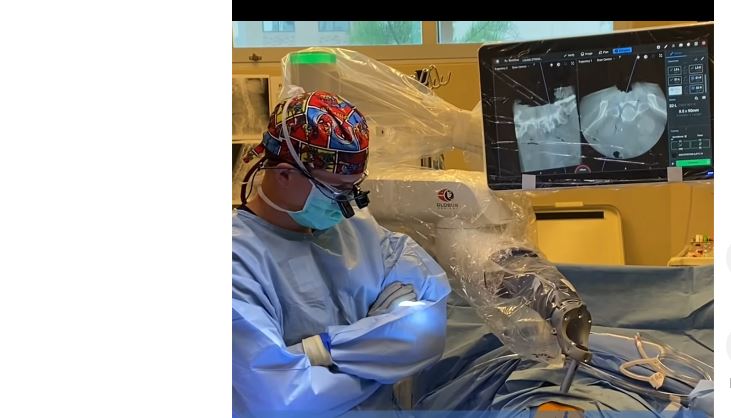
One of the most complex and dangerous medical specialties for a long time has been spinal surgery. In the past, surgeons had to rely entirely on their expertise and steady hands to handle the intricate web of bones and nerves. The field of spinal procedures has significantly improved in recent years due to technological advancements, with robot-assisted surgery leading the way.
The spine surgery robot operator, a highly qualified specialist who manages and enhances cutting-edge robotic systems to support surgeons, is at the center of this innovation. These operators are revolutionizing spinal surgery by improving accuracy, safety, and efficiency, making it more predictable, minimally invasive, and incredibly successful for patients all over the world.
Spine Surgery Robot Operator: Key Responsibilities and Technology
| Attribute | Details |
|---|---|
| Job Title | Spine Surgery Robot Operator |
| Primary Role | Assisting surgeons by controlling robotic systems for spinal procedures |
| Technology Used | Mazor Robotics, ROSA One, ExcelsiusGPS, Da Vinci Surgical System |
| Key Responsibilities | Operating and calibrating robotic systems, ensuring precision in screw placement, and minimizing surgical risks |
| Impact on Surgery | Enhances accuracy, reduces human error, allows for minimally invasive procedures |
| Skills Required | Medical robotics expertise, surgical navigation proficiency, problem-solving ability |
| Training Needed | Specialized certification in robotic spine surgery |
Why Spinal Surgery is Being Revolutionized by Robotics
Extreme precision is necessary for spinal procedures because even a millimeter of error can cause nerve damage, persistent pain, or decreased mobility. Through the use of AI-driven robotics, spine surgery has entered a new era marked by a notable improvement in patient outcomes and a significant decrease in errors.
Robotic-assisted spine surgery, in contrast to conventional freehand methods, combines haptic feedback and real-time imaging to enable surgeons to navigate the spinal column with previously unheard-of precision. By bridging the gap between human expertise and robotic precision, the spine surgery robot operator is essential to ensuring these systems operate flawlessly.
How Spine Surgery Robots Work: A Seamless Integration of Human and Machine
The process of robotic-assisted spine surgery follows a carefully planned sequence:
- Pre-Surgical Planning: The robot operator inputs high-resolution imaging data, mapping out an optimal surgical trajectory.
- Robotic Arm Guidance: The system precisely aligns surgical tools according to the surgeon’s plan, minimizing manual guesswork.
- Real-Time Adjustments: AI and haptic feedback allow operators and surgeons to make millimeter-level refinements during surgery.
- Minimally Invasive Execution: Robots enable smaller incisions, reduced blood loss, and faster healing, ultimately improving recovery times.
Through this exceptionally clear and highly efficient workflow, robotic surgery is rapidly becoming the gold standard in spinal procedures.
The Key Benefits of Robotic Spine Surgery
For both patients and healthcare providers, robotic spine surgery offers numerous advantages:
- Unmatched Accuracy: Robotic arms place screws and implants with sub-millimeter precision, significantly reducing errors.
- Reduced Human Fatigue: Unlike human hands, robotic instruments never tremble or tire, ensuring steady movements throughout lengthy procedures.
- Minimally Invasive Approach: Smaller incisions lead to less tissue trauma, reduced infection risks, and quicker recovery times.
- Enhanced Safety: With real-time imaging and robotic stabilization, the likelihood of surgical complications is remarkably lower.
By combining human skill with robotic intelligence, spinal surgery has transformed into a safer and significantly faster medical procedure.
Who Controls the Robot? The Vital Role of the Spine Surgery Robot Operator
Despite popular belief, surgical robots do not function independently. Instead, they act as sophisticated extensions of the surgeon’s hands, guided by highly trained operators who manage the system’s execution.
The spine surgery robot operator plays a critical role in:
- Configuring and calibrating the robotic system before surgery.
- Monitoring robotic precision to ensure flawless execution.
- Interpreting real-time imaging data for enhanced navigation.
- Facilitating seamless coordination between the robotic system and surgical team.
This profession demands a unique blend of technical expertise, surgical knowledge, and problem-solving skills, making it one of the most rewarding and future-proof careers in modern medicine.
Top Robotic Spine Surgery Systems
Spinal surgery is being revolutionized by a number of highly sophisticated robotic systems:
Robotic Mazor
Mazor’s Renaissance and Mazor X platforms, which are renowned for their unparalleled accuracy in pedicle screw placement, have significantly increased surgical accuracy in spinal fusion procedures.
The Zimmer Biomet ROSA One
A particularly cutting-edge system that is incredibly helpful for correcting scoliosis and spinal fusions because it is made for real-time imaging and precise spinal alignment.
Through Globus Medical, ExcelsiusGPS
With improved accuracy and workflow efficiency, this state-of-the-art navigation system is especially useful for open and minimally invasive spinal surgeries.
The Da Vinci Surgical System
The Da Vinci system is best known for general robotic surgery, but its ability to achieve micro-precision has made it a good choice for some intricate spinal operations.
Robotic operators will continue to lead surgical innovation as these technologies advance, guaranteeing that these systems will continue to transform spinal healthcare.
The Prospects for Robotic Spine Surgery Operators
Robot operators will play an increasingly important role as robotic-assisted surgery develops. The upcoming ten years will probably see:
- AI-Powered Robotics: Devices that gain efficiency and accuracy by learning from previous processes.
- Remote-Controlled Surgery: Using 5G connectivity, surgeons can operate on patients from any location in the world.
- Specialized Training Programs: To address the growing need for qualified operators, certification programs were developed with an emphasis on robotic-assisted spinal procedures.
- Robotic spine surgery will become the norm rather than the exception in the upcoming years, making qualified operators one of the most in-demand medical specialists.
A Career That Is Influencing Spinal Surgery’s Future
More than just a technical advance, robotic-assisted spine surgery is a revolution in patient outcomes, safety, and precision. One of the most innovative medical developments, this technology has demonstrated remarkable efficacy and efficiency in lowering risks and increasing success rates.
At the nexus of advanced technology and medicine, the spine surgery robot operator makes sure that robotic systems operate to their full potential. For individuals who are enthusiastic about healthcare innovation, this career path offers an incredibly exciting and future-proof opportunity due to the rapid evolution of AI-driven surgical tools.
In addition to being robotic, the future of spinal surgery is also fueled by human expertise, improved by accuracy, and brimming with unbounded possibilities.
